The 20 Best '80s Horror Movies Ranked
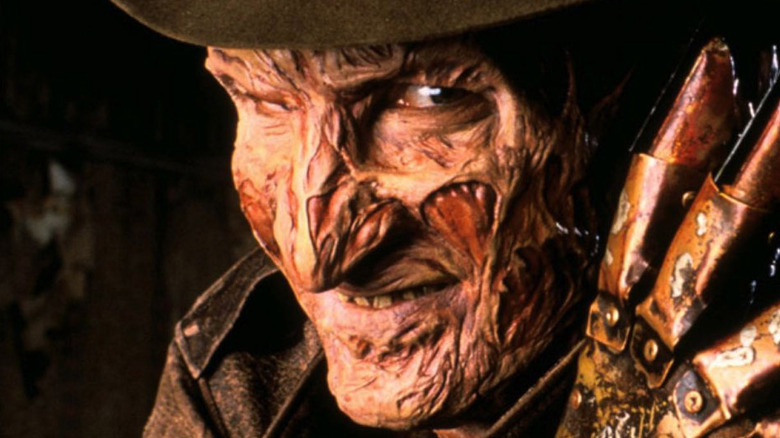
The '80s were a boom time for horror. Two formats of video recorder (VHS and Betamax) duked it out, with VHS eventually winning out due to being the cheaper format to license. The proliferation of this technology in the home meant that films had a market outside cinemas for the first time, and rental stores cropped up worldwide. Direct-to-video became a valid way to release films, and a lot of people wanted to cash in on the growing horror craze. In addition, because it was now possible to record movies from TV, many eager youngsters cultivated their interest in horror by watching scary movies at home, freed from the age-based restrictions at cinemas.
My childhood was one of regular video shop visits, marveling at the gory covers on cassettes in the horror section. The quality of the tapes varied wildly, but many still stand up today, some of them now bona-fide classics. Obviously, any list such as this is subjective, but there are a few entries that I'm genuinely sad missed the cut, even if just barely -- namely "Poltergeist," "The Shining," and "From Beyond."
Adjust your tracking, align your azimuth heads, and let's go...
Basket Case
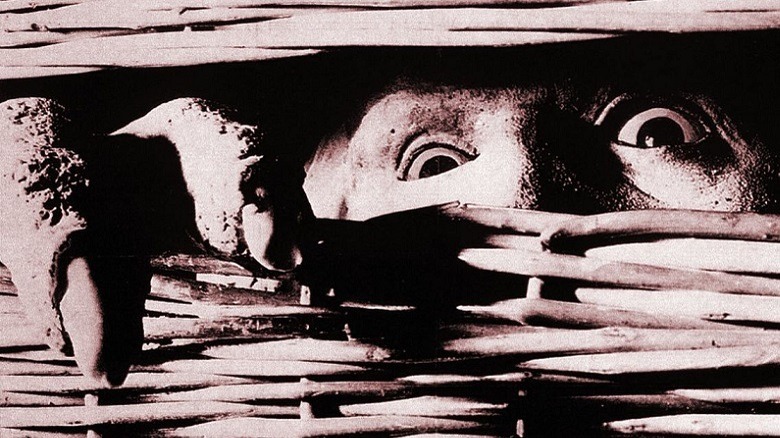
Frank Henenlotter has a rare directorial talent: the ability to cover every frame of celluloid with an intangible layer of grime. Across his limited yet illustrious career, New York has been as much a character in his films as any of the oddballs, eccentrics, or freaks he casts. "Basket Case" is as much a love letter to the Big Apple as anything made by Woody Allen, but concentrates on the city's rotten core: the seedy, sleazier side of the concrete metropolis.
"Basket Case" is a simple tale about a boy and his deformed mutant brother, but it's the humans in the film who are the real monsters. It's a tale that'll stick in your brain long after you've finished showering to try and wash the grubbiness away. Some of its effects are risible -- a stop-motion scene with monstrous brother Belial trashing a hotel room is more about the "stop" than the "motion" -- but, as with the rest of Henenlotter's work, there's a certain charm.
Henenlotter inspired a whole bunch of other filmmakers, notably Joe Begos ("Bliss" and "VFW") and Harrison Smith ("The Special"), proving that exploitation is alive and well. The "Basket Case" sequels veer more towards black comedy and away from horror, but are never less than watchable.
Predator
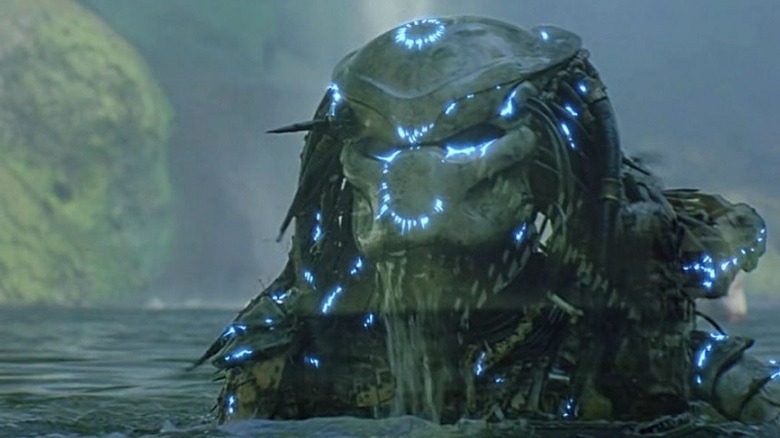
In some little backwater alternate reality, there's a far different version of "Predator" from the one that hit cinemas in 1987. In this universe, it's one of the more obscure movies of Schwarzenegger's oeuvre, an action-horror flick starring heavily disguised, little-known actor Jean-Claude Van Damme (who suffered a career-ending injury after an ill-timed jump in a preposterous looking rubber costume).
Luckily, that's not the one we got. Featuring the ever-reliable designs of genre genius Stan Winston, "Predator" is an unashamedly macho science-fiction action-horror movie which sees Dutch (Arnie) and his squad of war-film stereotypes take on the eponymous alien menace. Featuring enough ammunition to topple a third-world dictatorship, and biceps bulging with more veins than most of us have in our entire circulatory systems, "Predator" is an absolute blast.
Like Billy on the bridge, brave enough to take on the Predator with just a machete, the film is expertly executed. A novel sequel that moved the setting to the concrete jungle of Los Angeles was followed by increasingly dismal movies, but, unlike the Predator himself, the franchise refuses to vanish.
Gremlins
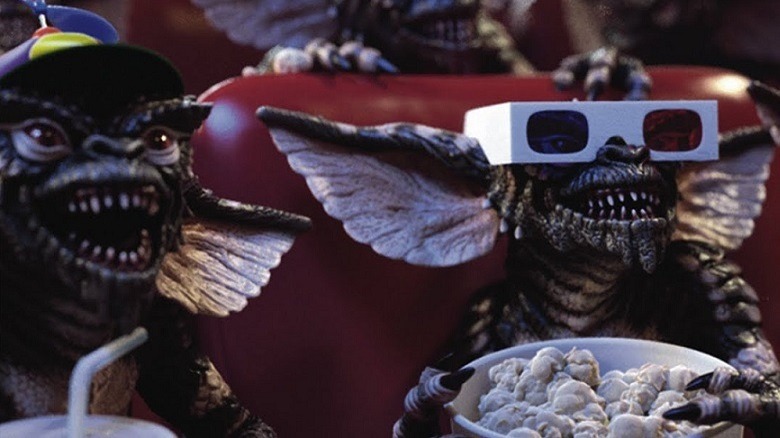
A rare piece of stealth-horror, this one, sneaking from the video store shelf into many homes thanks to the cute furry Mogwai on the cover. It'd be a little while before its true nature became apparent: "Gremlins" is a Tex Avery cartoon given lizard flesh, a violent, blood-spattered tale of evil little skittering demonic creatures. My nervous mother (who'd subsequently tried to warn me away from "Rosemary's Baby," calling it the "scariest movie ever") never quite forgave me.
At its heart, "Gremlins" is a movie-length cautionary tale, a reminder to always follow instructions. The gremlins and their leader, Stripe, are the yin to the cute Mogwai Gizmo's yang, wreaking havoc amongst the deserving and undeserving alike. The gremlins themselves are a force of nature, dispatched in a variety of grisly ways that'll delight the childish-at-heart and sicken people ;ole my dear-departed mum. It's manic, playful, and buzzing with a sugar-rush energy rarely found outside of Saturday morning cartoons, but there's a hint of the darkest elements of Grimm just lurking under the surface -- Phoebe Cates' saddest Christmas story of all time is testament to that.
"Gremlins" is a film that gets away with a lot due to the violence being cartoonish and over-the-top, but that doesn't stop it being as worthy an entry as anything on this list.
The Evil Dead
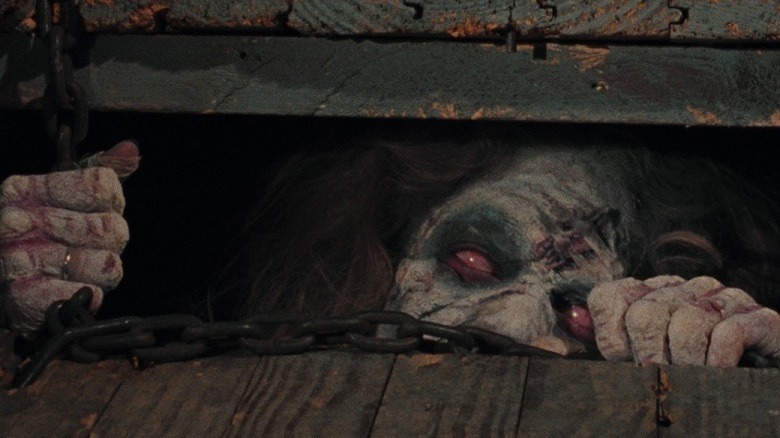
Whatever they try and tell you, nostalgia is what it used to be. A lot of my love for the movies on this list isn't simply due to the films itself, but the memories the films evoke of times, places, and friends.
The early '80s saw the Video Nasty uproar in the UK, in which movies -- typically from the horror and exploitation genres -- were banned under the Obscene Publications Act, and filmmakers and distributors found themselves prosecuted. Bootleg VHS cassettes of "Video Nasties" were forced underground, passed between avid collectors and fans like a Russian athlete's urine samples at the 2014 Winter Olympics.
"The Evil Dead" was one such movie, with this writers' first experience of the seminal horror film being in a grubby caravan in a friend's garden in the summer of 1983. It could be argued that the sequel -- effectively a bigger budget remake of the first -- is the better movie, but there's a low-fi charm to the original. There's a joy in this style of guerrilla filmmaking, wringing the very most out of a non-existent budget. "The Evil Dead" displays all the hallmarks that Sam Raimi would come to be known for; bold camerawork, a frenetic pace and style, and a comic-book sensibility. The less said about the tree molestation scene, though, the better.
The Blob
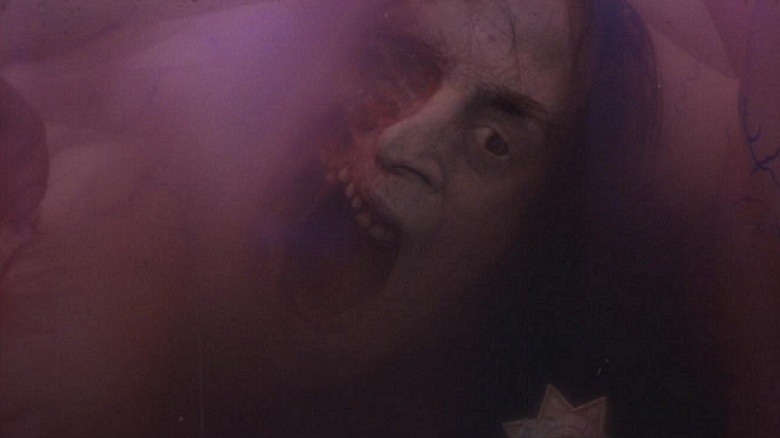
"The Blob" is just one of several remakes on this list, all of which follow the same principle; do it bigger and better. The Steve McQueen original is a well-regarded, cheesy science-fiction B-movie with a novel and original antagonist. The remake is a brilliant piece of '80s body horror that time seems to be doing its darned best to forget.
Like Tom Savini's excellent remake of "Night of the Living Dead," the remake plays with the ideas of the original while subverting them for a modern audience. The jock that the film seems to be setting up to be the lead dies (horribly) in the first act, writer Frank Darabont and director Chuck Russell seem to have missed the bit in the Hollywood scriptwriter's handbook that says, "Don't kill any kids," and it all fits neatly with the '80s' obsession with conspiracies -- "It was the Government what did it."
"The Blob" also sets itself up neatly for a sequel that would never come, the film getting lost amongst a heaving morass of summer releases. Still, it's great fun with some truly memorable gross-out moments, and, aside from some dated back projection work, still stands up well.
Halloween 3: Season Of The Witch
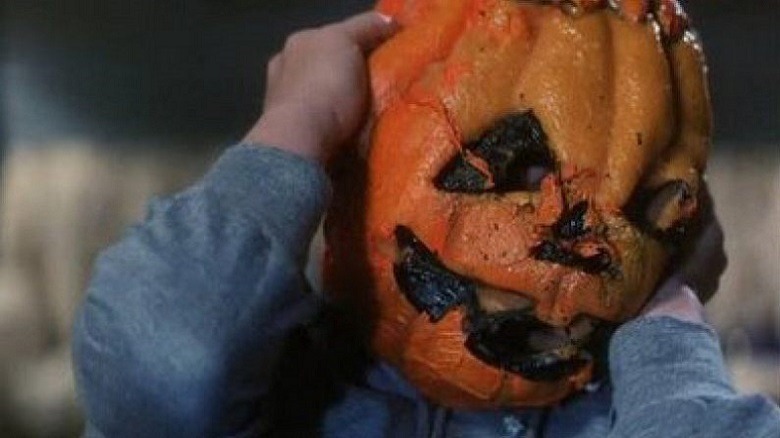
Narrowly beating another John Carpenter movie ("The Fog") for a place on the list, "Halloween 3" sits in such a prominent position simply for trying -- albeit failing -- to do something new with the developing franchise. Attempting to break away from being simply the continuing saga of Michael Myers, this was a bold attempt to push the Halloween franchise in a new direction; namely, to make it a series of horror films based around the holiday itself, with no link to the Shape.
With a script originally by Nigel Kneale (of "Quatermass" fame), "Halloween 3" is a folk-horror tale at heart, brimming with concepts that Kneale relished, like the overlap between technology and old magic. He eventually distanced himself from the project, but his name runs through it like the writing on a stick of rock.
However, the true magic at work here is the sheer sexual magnetism of lead actor Tom Atkins. Jamie Lee Curtis' character in "The Fog" beds him within moments of meeting him, as does his investigative partner -- Ellie Grimbridge -- in this. Despite dodgy Irish accents and a jingle that'll infest your brain for weeks, "Halloween 3" is, in this writer's humble opinion, the best of the series.
An American Werewolf In London
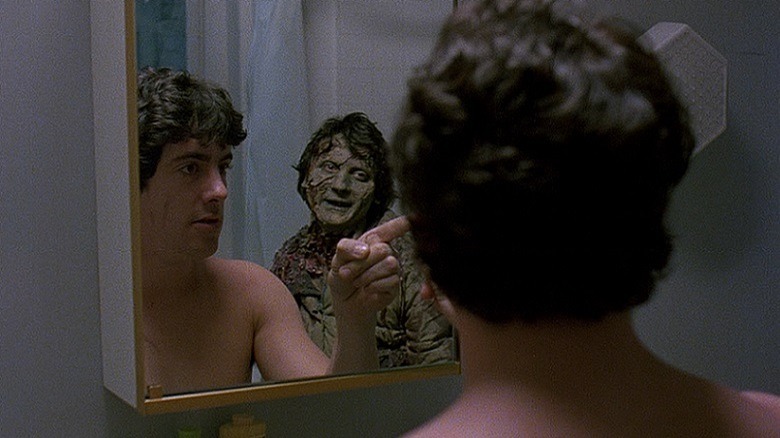
Thanks to "An American Werewolf in London" there are a whole plethora of songs with "Moon" in the title that will trigger a Pavlov-conditioned response among a certain generation of horror fans, evoking imagery of violent transformations, unwelcoming taverns, and Jenny Agutter in a shower.
For a director with a rich heritage in comedy, "An American Werewolf in London" fits neatly into John Landis' filmography. It's a horror movie with a bloated, black comedic heart, elevating itself above its lupine peers from the same decade (namely, "The Howling" and its sequels). For an audience expecting the werewolf transformation to consist of the lead actor having more fur glued to his face before he appears from behind a piece of furniture, Rick Baker's moonlight change from David to lycanthrope was a revelation. This was no elegant metamorphosis from wolf to man, but an agonizing and brutal act in which bones rearranged themselves and skin stretched to the point of tearing open.
Effects aside, "An American Werewolf in London" is horror with genuine depth, faithful to the werewolf tradition, but with a modern slant. A risible sequel emerged from the moors nearly two decades later, but with none of the charm or humor of this horror classic.
Society
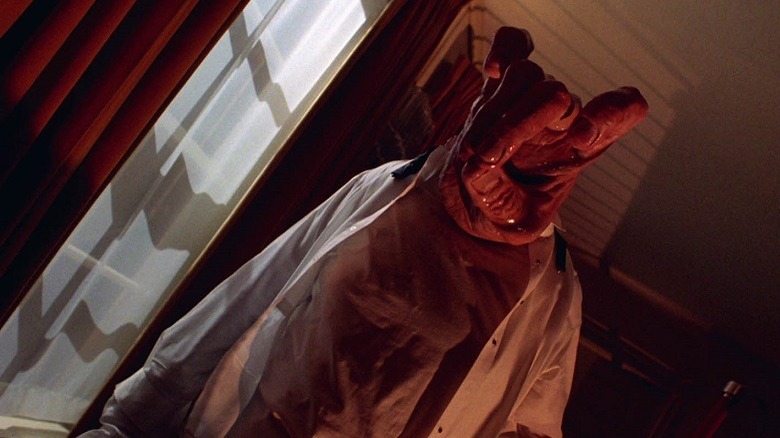
"Shunting." Such an innocent term, conjuring (to this Brit, anyway) images of steam trains and the golden age of rail. Well, watching "Society" will banish any such romantic notions from your brain, replacing the word's meaning with gross physical deformations and disgusting bodily absorptions.
Responsible for the notorious KY Jelly shortage of 1989, "Society" is a distinct film of two halves, a shifting amorphous mass that's ingested David Cronenberg and the cast of "Beverly Hills 90210." It introduces a metaphor as subtle as a house-brick to the chin, taking the adage to a logical -- and repugnant -- extreme: What if the parasitic rich really were feeding off the poor?
"Society" is trickle-down economics given malleable flesh, with a delightfully exuberant and grotesque final act that's well worth the wait. The aptly named Screaming Mad George is on FX duty in this paranoiac satire, and the practical special effects still stand out three decades later. Are the soulless incestuous people of "Society" aliens, or have they been here all along? A question still as valid and equally as unanswered today.
Day Of The Dead
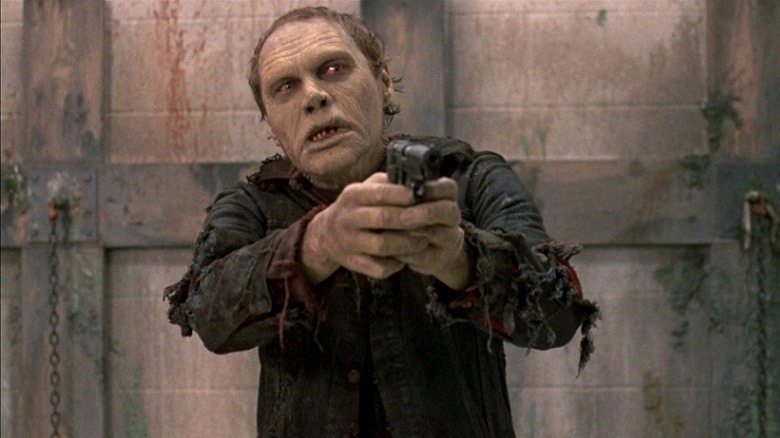
Any list of the top 20 horror movies of the '60s wouldn't be complete without "Night of the Living Dead," and to leave "Dawn of the Dead" out of a '70s chart would be verging on illegal. Similarly, "Day of the Dead" rightfully deserves a position here. Romero would ensure that the increasingly inaccurately titled "Trilogy of the Dead" would receive more entries in the next century, but none stand up to the original three.
The "Day of the Dead" trailer alone was enough to terrify audiences, an early example of a jump scare taken from the opening scene. As the (supposed) final entry in the trilogy, it portrays a group of survivors who may be the last remnants of mankind, hunkered together in an underground bunker. The last stragglers of a military operation which should have been long abandoned, it's a claustrophobic character study of confinement, as well as an excuse for some truly memorable and horrific effects work from Romero's long-time collaborator, Tom Savini.
Captain Rhodes' soldiers are just as terrifying as any of the undead, and it's the conflict between them and the civilian scientists that make for a tense and brutal showdown. The three surviving leads (Lori Cardille, Jarlath Conroy, and Terry Alexander) recently appeared together in intriguing photographs hinting at a return for the characters in an unofficial sequel to "Day of the Dead," nearly four decades later.
Creepshow
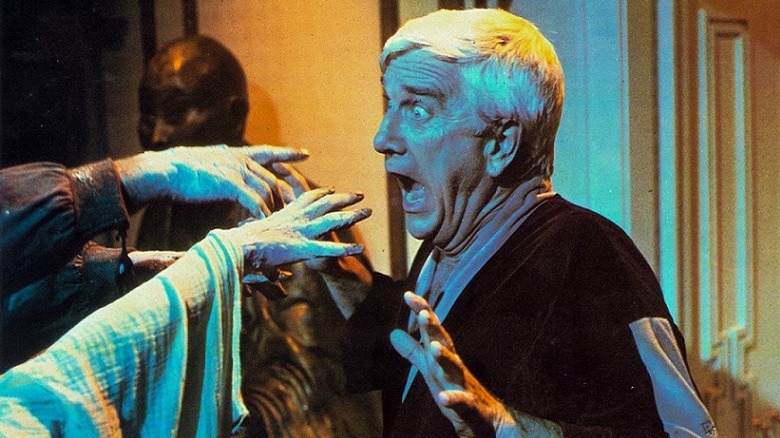
As a sucker for a well-done anthology movie, "Creepshow" is one of the better ones, edging out "The Twilight Zone" movie. A loving tribute to the old EC Horror comics of the '50s, it was the first collaboration between the sadly missed George A. Romero and Stephen King.
Whereas some '70s films brought EC Horror stories directly to the big screen (Amicus Productions' "Tales from the Crypt" and "The Vault of Horror"), "Creepshow" was simply inspired by the feel and theme of these comics. They all follow a similar pattern. All of the segments are modern morality tales: They're all about bad people doing dreadful things to good people, and eventually get their comeuppance. One segment starring King himself -- "The Lonesome Death of Jordy Verrill" -- acts more as a cautionary tale, the sage warning being, "Don't get meteor crap on your fingers."
The comic book motif is strong throughout, shots framed by borders with expositional text or filmed at bizarre angles, mimicking comic book panels. Lighting is in bold, garish colors, aping the four-color printing process of the source material, and scenes elegantly transition with the turning of pages. A standout cast is the cherry on the icing-topped, severed-head cake.
Re-Animator
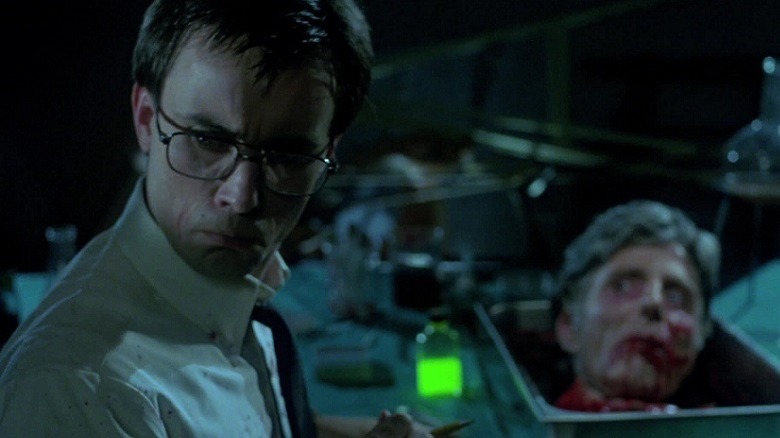
Jeffrey Combs is a little like Michael Ironside in that both men elevate any material that they're in; even the dullest of films is enlivened by Jeffrey's manic presence, and there's no better vehicle for him than Stuart Gordon's "Re-Animator." There's a reason the actor's filmography is as long as your freshly severed arm, and this movie would have been many audience members' first experience of him.
Loosely based on the H.P. Lovecraft story of (nearly) the same name, "Re-Animator" sees a perfectly cast Combs play a medical student fixated on reanimating the dead. He's obsessed to the point of madness, channeling Colin Clive as Doctor Frankenstein in the James Whale classic.
Like many films in this list, "Re-Animator" is another horror comedy from a decade in which they positively thrived. Adding a rich vein of humor to your movie was a common delivery mechanism for conjuring up increasingly outlandish special effects and gore, and "Re-Animator" is a blood-spattered rollercoaster ride. The plot is as lurid as the bright luminous green of the re-animation serum, all reanimated heads and monstrous resurrected chimeras, only to fall into dark farce as West's ill-fated plans go awry.
Killer Klowns From Outer Space
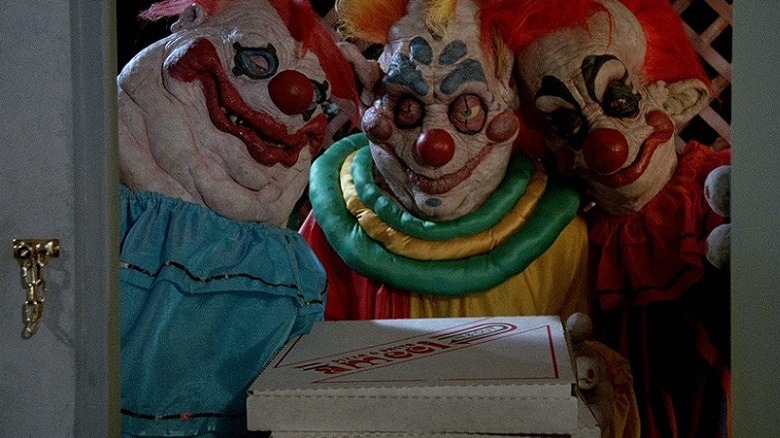
History shows us that the worst way to make a cult movie is to try and make one -- however, in "Killer Klowns from Outer Space," the Chiodo brothers achieved exactly that. It shouldn't work. There are very few scares, and the entire concept is laughable. But for some reason "Killer Klowns" has remained in the public consciousness for longer than it ever deserved to.
There's an amazing, frenetic, campy B-movie energy to the entire film, which succeeds by having a main cast that takes the whole thing seriously. Every avenue of clownery is explored; big-top spacecraft, monstrous popcorn jack-in-the-boxes, and death by custard pie. It's Peter Jackson's "Bad Taste" with more ambition and a bigger budget, a movie destined for drive-through cinemas and big crowds. It achieves exactly what it sets out to do, throbbing red nose and all.
Worthy of note is the key ingredient of John Massari's energetic soundtrack, shifting effortlessly between atmospheric pieces and raucous Looney Tunes-style fairground calliope and organ. The main theme by '70s punk band The Dickies makes this worth a rewatch all on its own.
The Fly
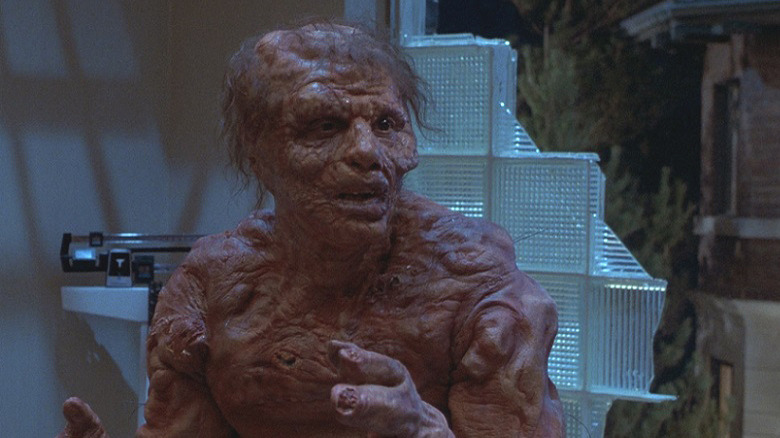
Another remake on this list that's better than the original, "The Fly" is auteur David Cronenberg operating at his very peak with arguably one of his most mainstream films to date. The story -- a surprisingly close adaption of the 1958 movie -- is a perfect vehicle for the director's fascination with the degeneration of the human body, disease, mutation, and entropy.
In a movie about two disparate entities fused together in an accident, "The Fly" is also a hybrid: a tale of both doomed love and graphic body horror. What begins as a convincing romance between Veronica and Jeff Goldblum's eccentric yet charming scientist, Seth Brundle, mutates into something far darker. Released during the height of the AIDS epidemic, hindsight gives it a particular relevance,
It's difficult to discuss the movie without it falling into glorious fawning appreciation over the incredible effects. A mixture of state-of-the-art prosthetics and animatronic work, Brundle's degradation from man to insect is as wonderfully realized as it is heartbreaking. Whereas the original saw the scientist separated into two distinct entities (making for a truly memorable ending), Cronenberg sees them fused into one, an amalgam with a similarly doomed fate.
Hellraiser
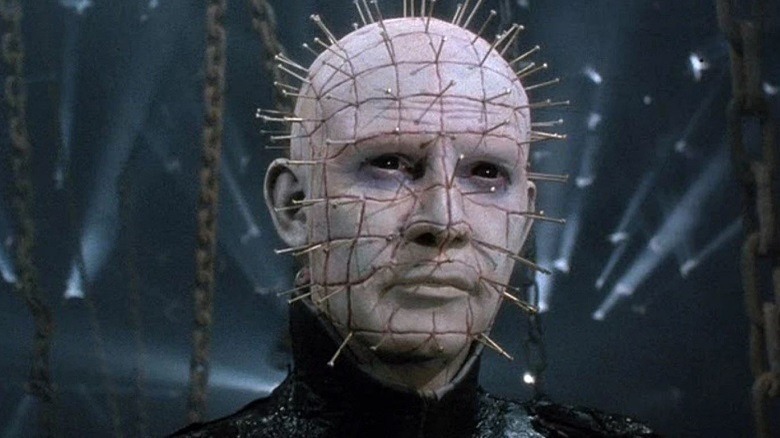
Clive Barker remains a unique voice in horror. "The Hellbound Heart" -- the novella that became "Hellraiser" -- was a tale of obsession and dark passions, of unspeakable creatures from a radically different Hell, a blasphemous terrain of dark order. It was Barker's first stab at directing, and to advantageous effect. There is a beautiful charm to the movie, a confidence that knows it's unlike anything seen before. It's heavy with its own mythology, as though we are only witnessing a tiny fragment of Barker's vision.
Elements of "Hellraiser" have aged poorly -- an ill-conceived and overly swift resolution is matched by equally weak effects -- but it still stands out as something unique. It seems like an unlikely movie to spawn its own horror legend, but Doug Bradley's lead Cenobite ended up in fine company alongside Krueger, Leatherface, Jason, et al. But Pinhead wasn't even named until the sequels; like a magic trick, the more we knew about him, the less special he became. Familiarity bred contempt, even for the Pope of Hell. Still, there is a dark magic at work in the first movie, and to some extent the second, for those who dare to brave the Lament Configuration.
Near Dark
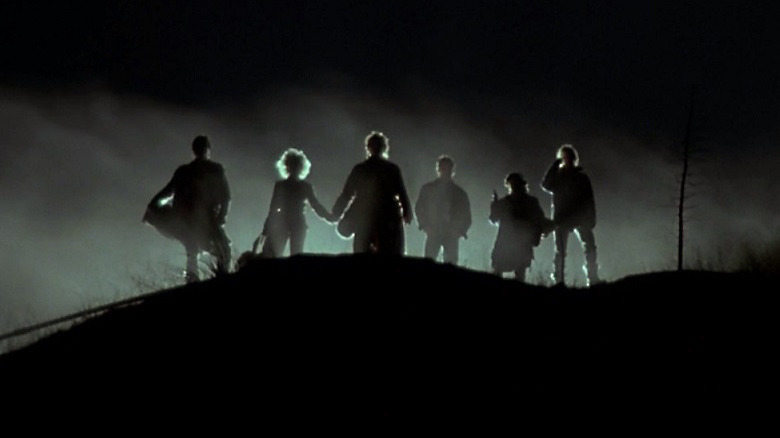
If a horror movie could be said to only be as good as its villains, there's a reason that "Near Dark" makes this list while films like "The Lost Boys" and "Fright Night" don't make the grade. Jesse Hooker and his miscreant gang of fanged fanatics would wipe the floor with Jerry Dandridge, along with David and his hair-metal kin.
Hooker's gang are no preening 20-somethings whose excessive hairspray would cause them to go up like kindling if exposed to flame, nor are they smooth-talking, overly confident seducers. They're predators at top of the food chain, and vampires have rarely appeared as threatening or as menacing as they do here.
"Near Dark" is a vampire western, albeit one where the "V" word is never mentioned. It's also another wonderful pairing between Lance Henriksen and the sadly missed Bill Paxton, the only two actors to be killed by a Predator, Terminator, and Xenomorph. It's a wonderfully confident solo directorial debut by Kathryn Bigelow, who plays with the conventions of the genre conventions and has the chutzpah to stage the final conflict between hero Caleb (Adrian Pasdar) and Severen (Paxton) in a street, "High Noon" style. It's a beautifully lean movie as well, and never outstays its welcome.
Aliens
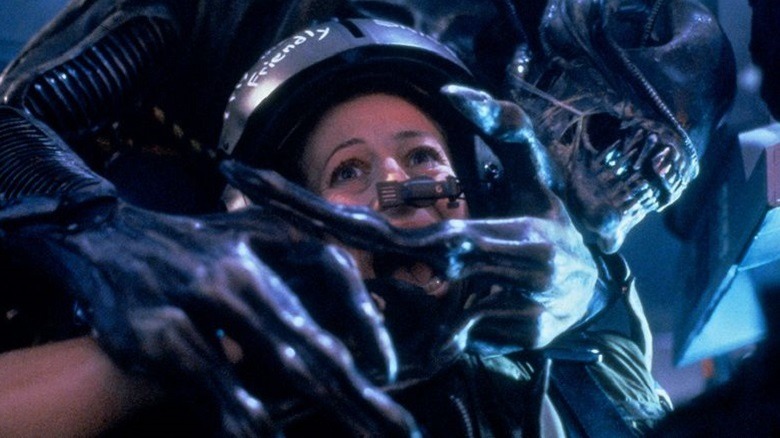
James Cameron's original pitch for "Aliens" is rumored to have begun with him writing the title on a whiteboard and adding the S to the end as a dollar sign -- "Alien$." If not apocryphal, then arrogant. Accurate? Resulting in a classic sequel to a classic original thought impossible to match or beat, that would be hard to argue.
Effortlessly shifting the central theme from a haunted house to the Vietnam War, "Aliens" has been the obvious inspiration for many films across the past three decades. Its strength is that it's still just as much Ripley's tale as the original. It simply ups the scale and the scope.
The Xenomorphs are back, but this time they've brought their mum. Thanks to a particular deleted scene from "Alien", the vicious fanged beasties' life-cycle was never fully explained, giving us a creature even more terrifying than Giger's slavering obsidian whirlwind of tooth and claw: the Alien Queen. It's easy to forget that "Aliens" is a masterclass in storytelling too, with not a frame or line of dialogue wasted. It's the only film I ever owned where the video cassette ended up worn out from overuse, which is the highest praise I can bestow upon any movie.
The Thing
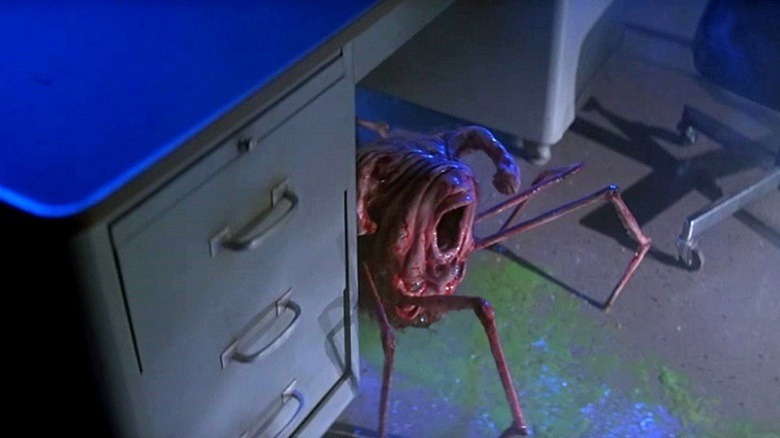
It's weird to think now, given that by law it must now appear on most top 10 film lists, that "The Thing" was a flop on release. It barely made its budget back and was mauled in the press. The ambiguous ending was derided, and it was labelled by critics and audiences alike as "stupid", "nihilistic" and "boring."
But "The Thing" is a masterpiece in both horror and tension, back from when Carpenter was at the absolute top of his game. Easily as much a siege movie as his earlier "Assault on Precinct 13," "The Thing" traps its distinct and identifiable cast in the middle of nowhere -- Antarctica -- and then throws a distinctly slimy spanner in the works.
When "The Thing" was made, aliens in science fiction films were still mostly men in rubber suits, something that even Howard Hawks' original "The Thing from Another World" was guilty of. In Carpenter's cover version -- and, to some extent, the Xenomorph in Ridley Scott's 1979 classic "Alien" -- we were given an alien that was truly that: alien. With a motive as vague as its nebulous appearance, we were presented with a truly remarkable adversary. We're also lucky enough to see how it would have fared with CGI rather than practical effects in the identically titled prequel from 2011; the new version is by far the lesser film for it.
A Nightmare On Elm Street
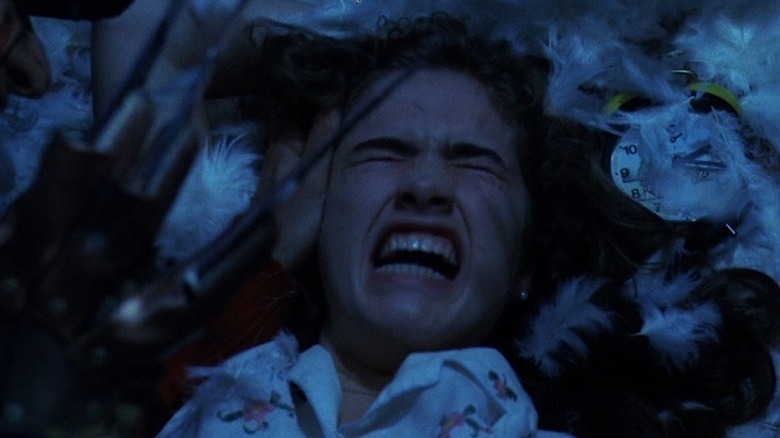
It's easy to forget that in the time before he became a one-line-wisecracking Funko pop culture icon, sweater-wearing burn enthusiast Freddy Krueger was a genuinely terrifying villain. In the first -- and best -- of the Elm Street series, before it forgot its own rules and logic, the son of one hundred maniacs was a terrifying new figurehead in horror. In a decade plagued with wannabe franchises and countless bladed baddies, Elm Street stands out.
In a transformation as unexpected as that of Michael Keaton becoming Batman, a prosthesis-and-latex-smothered Robert Englund (better known as sweet Willie from the TV series "V") becomes the dream demon, slaughtering his way through Springwood's children like a bladed Herod. Nancy Thompson (Heather Langenkamp), cursed to meet the man of her dreams, makes for an excellent foil and final girl. Bed is where she should feel safe, so to have a villain who can invade the sanctity of sleep is a terrifying concept. It's an idea used less effectively as the series goes on, but in this first movie the dream sequences are unnerving, tinged with a surreal edge -- genuinely feeling like the stuff that nightmares are made of. Forget the mediocre remake -- Wes Craven's original is easily the best.
Little Shop Of Horrors
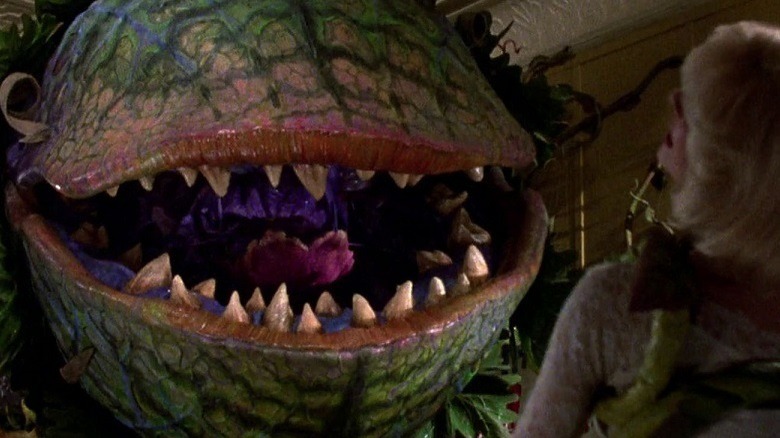
A convoluted origin, this: "Little Shop of Horrors" is based on a 1982 stage musical which, in turn, was based on a 1960 Roger Corman horror comedy. It's inclusion on this list is a reminder that horror doesn't necessarily need to be about scares and gore. It can be fun. A brutal premise (an innocent man, corrupted by thoughts of fame and power, feeds human flesh to a ravenous meat-eating plant) is executed with humor and panache, all to a wonderful soundtrack of crowd-pleasing songs, most of them show-stoppers.
With animatronic puppet work to rival anything in "The Thing," "Little Shop of Horrors" is a visual delight too, and one of the few items on this list that remains (essentially) family friendly. As evidenced by the work of Roald Dahl, kids love the macabre, so consider "Little Shop of Horrors" their gateway drug to greater and darker pleasures later in life.
In an interesting coda, the original ending was considerably more downbeat, seeing giant kaiju-scale rampaging plant creatures destroying New York and, inevitably, the world (all to the accompaniment of "Don't Feed the Plants," one of the film's best songs). The actual ending to the movie is more upbeat (with a slightly hackneyed and predictable twist), so I happily consider the darker finale to be the proper ending.
Return Of The Living Dead
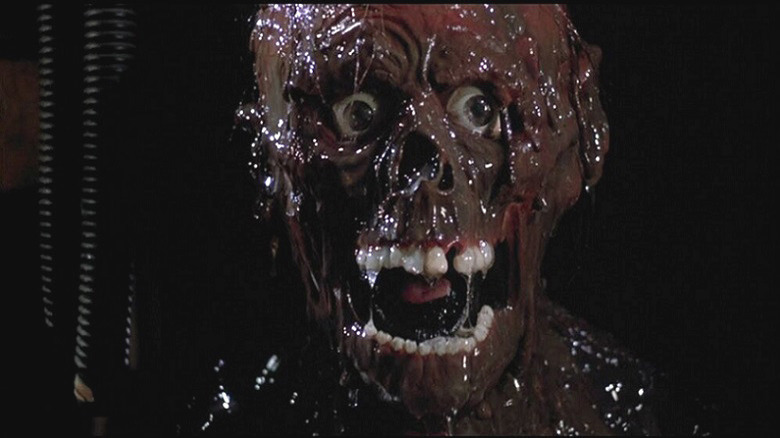
After a dispute between George A. Romero and writer John Russo over potential sequels to 1968's "Night of the Living Dead," it was agreed they could both do their own, with Russo having control over the "Living Dead" suffix. Hence, 1985's "Return of the Living Dead," a canonical sequel that acknowledges that the previous film was fictional, albeit based on a real event. It inherits very little from its predecessor except for its pessimistic ending, the rest being unashamed slapstick and comic-book violence.
A leakage from a sealed canister of Trioxin resurrects the occupants of a nearby graveyard, threatening the lives of both a group of punks direct from central casting and employees of the nearby morgue. It's played as much for laughs as scares and is possibly the first film to introduce the concept of zombies passionately declaring their great fondness for human brains (incidentally, previous research under my horror writer secret identity has identified that brains are quite calorific, and a far from ideal snack).
Memorable for some gratuitous nudity from scream queen Linnea Quigley and for introducing the shambling oily corpse known as Tarman, "Return of the Living Dead" is a perfect macrocosm of '80s horror; confident, brash, gory, and sadly prone to spawning a set of inferior sequels that barely do justice to the original. "Send ... more ... paramedics!"
Read this next: 19 Movies Like 'Fear Street' To Stream Or Rent Right Now
The post The 20 best '80s horror movies ranked appeared first on /Film.
from /Film https://ift.tt/3DuM6Oe
No comments: